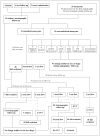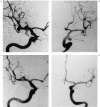Multiple intracranial aneurysms. Angiographic study and endovascular treatment
- PMID: 20594518
- PMCID: PMC3576617
- DOI: 10.1177/159101990200800201
Multiple intracranial aneurysms. Angiographic study and endovascular treatment
Abstract
We evaluate endovascular treatment (EVT) as an option to deal with multiple intracranial aneurysms(MA). From 1994 to 2001, 24 patients underwent EVT for 59 MA. Patients were followed- up clinically and angiographically in a period ranging from 6 to 93 months (mean time of 22.2) and from 4 to 69 months (mean time of 19.3), respectively. Ten patients (41.6%) were treated either by EVT (n=7, 29,16%) or by mixed treatment (EVT and surgery; n=3, 12.5%). Reasons for treating just ruptured aneurysms: six (25%) had aneurysms smaller than 5 mm; three (12.5%) deaths; two (8.33%) were in the subacute period; two (8.33%) lost to follow-up; one (4.17%) authorised no procedure. No rebleeding was detected at the clinical follow-up, but there were five deaths.At immediate arteriographic control: 28 (85%) aneurysms were fully occluded, four (12%) with neck flow and one (03%) with sac flow. For 20 aneurysms followed-up: stability of occlusion was reached in seven cases (35%) and repermeabilization in 13 (65%). Management of recanalization was close arteriography in seven (54%), re-embolization in five (38%) and surgery in one (08%). When treating MA, EVT is advisable either alone or in mixed therapy. As a high degree of repermeabilization was disclosed, strict arteriographic control is required. The mechanisms underlying aneurysmal formation may be also involved in the recanalization phenomenon , a possible new manifestation of the fragility of the arterial wall.
Figures





Similar articles
-
Feasibility and midterm outcomes of endovascular embolization for true posterior communicating artery aneurysms.Neuroradiology. 2019 Oct;61(10):1191-1198. doi: 10.1007/s00234-019-02277-y. Epub 2019 Aug 10. Neuroradiology. 2019. PMID: 31401724
-
Influencing factors of immediate angiographic results in intracranial aneurysms patients after endovascular treatment.J Neurol. 2015 Sep;262(9):2115-23. doi: 10.1007/s00415-015-7824-2. Epub 2015 Jun 24. J Neurol. 2015. PMID: 26100332
-
Causes of early rebleeding after coil embolization of ruptured cerebral aneurysms.Clin Neurol Neurosurg. 2018 Nov;174:108-116. doi: 10.1016/j.clineuro.2018.09.006. Epub 2018 Sep 5. Clin Neurol Neurosurg. 2018. PMID: 30232054
-
Idiopathic aneurysms of distal cerebellar arteries: endovascular treatment after rupture.Neuroradiology. 2008 Feb;50(2):161-70. doi: 10.1007/s00234-007-0315-0. Epub 2007 Oct 23. Neuroradiology. 2008. PMID: 17955231 Review.
-
Risk factors for angiographic recurrence after treatment of unruptured intracranial aneurysms: Outcomes from a series of 178 unruptured aneurysms treated by regular coiling or surgery.J Neuroradiol. 2017 Sep;44(5):298-307. doi: 10.1016/j.neurad.2017.05.003. Epub 2017 Jun 8. J Neuroradiol. 2017. PMID: 28602498 Review.
Cited by
-
Giant spinal perimedullary fistula in hereditary haemorrhagic telangiectasia: diagnosis, endovascular treatment and review of the literature.Neuroradiology. 2003 Nov;45(11):830-6. doi: 10.1007/s00234-003-1044-7. Epub 2003 Oct 14. Neuroradiology. 2003. PMID: 14557903 Review.
-
Clinical Characteristics and Outcome of Patients with Multiple Intracranial Aneurysms from a University Hospital in Nepal.Asian J Neurosurg. 2022 Aug 24;17(2):268-273. doi: 10.1055/s-0042-1750822. eCollection 2022 Jun. Asian J Neurosurg. 2022. PMID: 36120613 Free PMC article.
-
Endovascular management for intracranial ruptured aneurysms in elderly patients: outcome and technical aspects.Neuroradiology. 2005 Jun;47(6):446-57. doi: 10.1007/s00234-005-1345-0. Epub 2005 May 11. Neuroradiology. 2005. PMID: 15887012
-
Single-Stage Coil Embolization of Multiple Intracranial Aneurysms: Technical Feasibility and Clinical Outcomes.Clin Neuroradiol. 2016 Sep;26(3):285-90. doi: 10.1007/s00062-014-0367-6. Epub 2014 Dec 17. Clin Neuroradiol. 2016. PMID: 25516149 Clinical Trial.
References
-
- Juvella S, Porras M, Heiskanen O. Natural history of unruptured intracranial aneurysms: a long term follow-up study. J Neurosurg. 1993;79:174–182. - PubMed
-
- Fox AJ, Drake CG. Detachable balloon embolization for intracranial aneurysms. J Neurosurg. 1990;73:157–159. - PubMed
-
- Fox AJ, Vinuela F, et al. Use of detachable balloons for proximal artery occlusion in the treatment of unclippable cerebral aneurysms. J Neurosurg. 1987;66:40–46. - PubMed
-
- Guglielmi G, Vinuela F, et al. Electrothrombosis of saccular aneurysms via endovascular approach. Part 2: Preliminary clinical experience. J Neurosurg. 1991;75:8–14. - PubMed
-
- Higashida R, Halbach VV, et al. Intracranial aneurysms: interventional neurovascular treatment with detachable balloons results in 215 cases. Radiology. 1991;178:663–670. - PubMed
LinkOut - more resources
Full Text Sources
Research Materials

